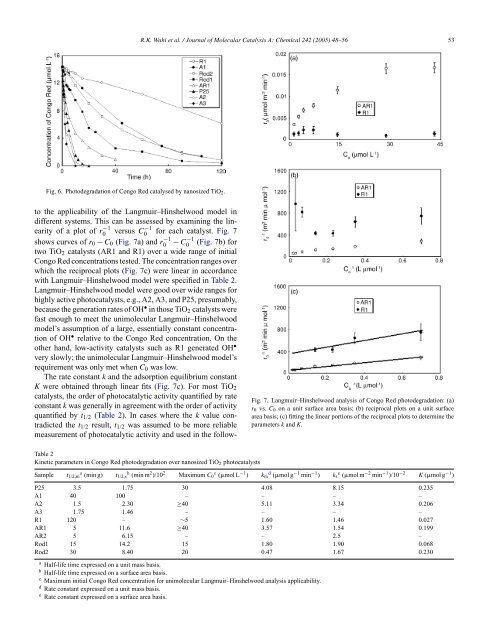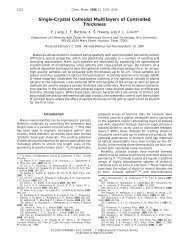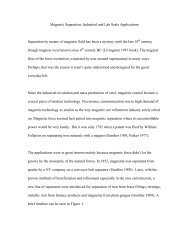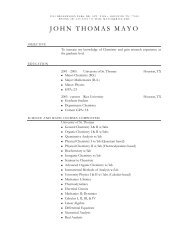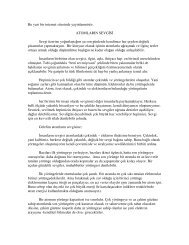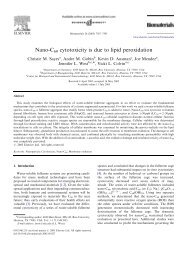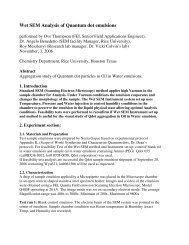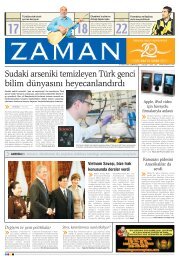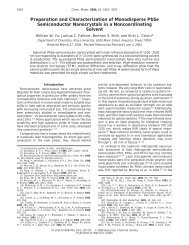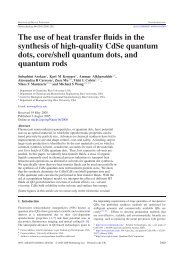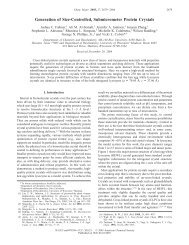Photodegradation of Congo Red catalyzed by nanosized TiO2
Photodegradation of Congo Red catalyzed by nanosized TiO2
Photodegradation of Congo Red catalyzed by nanosized TiO2
Create successful ePaper yourself
Turn your PDF publications into a flip-book with our unique Google optimized e-Paper software.
Fig. 6. <strong>Photodegradation</strong> <strong>of</strong> <strong>Congo</strong> <strong>Red</strong> catalysed <strong>by</strong> <strong>nanosized</strong> <strong>TiO2</strong>.<br />
to the applicability <strong>of</strong> the Langmuir–Hinshelwood model in<br />
different systems. This can be assessed <strong>by</strong> examining the linearity<br />
<strong>of</strong> a plot <strong>of</strong> r −1<br />
0 versus C −1<br />
0 for each catalyst. Fig. 7<br />
shows curves <strong>of</strong> r0 − C0 (Fig. 7a) and r −1<br />
R.K. Wahi et al. / Journal <strong>of</strong> Molecular Catalysis A: Chemical 242 (2005) 48–56 53<br />
0<br />
− C−1<br />
0 (Fig. 7b) for<br />
two <strong>TiO2</strong> catalysts (AR1 and R1) over a wide range <strong>of</strong> initial<br />
<strong>Congo</strong> <strong>Red</strong> concentrations tested. The concentration ranges over<br />
which the reciprocal plots (Fig. 7c) were linear in accordance<br />
with Langmuir–Hinshelwood model were specified in Table 2.<br />
Langmuir–Hinshelwood model were good over wide ranges for<br />
highly active photocatalysts, e.g., A2, A3, and P25, presumably,<br />
because the generation rates <strong>of</strong> OH • in those <strong>TiO2</strong> catalysts were<br />
fast enough to meet the unimolecular Langmuir–Hinshelwood<br />
model’s assumption <strong>of</strong> a large, essentially constant concentration<br />
<strong>of</strong> OH • relative to the <strong>Congo</strong> <strong>Red</strong> concentration. On the<br />
other hand, low-activity catalysts such as R1 generated OH •<br />
very slowly; the unimolecular Langmuir–Hinshelwood model’s<br />
requirement was only met when C0 was low.<br />
The rate constant k and the adsorption equilibrium constant<br />
K were obtained through linear fits (Fig. 7c). For most <strong>TiO2</strong><br />
catalysts, the order <strong>of</strong> photocatalytic activity quantified <strong>by</strong> rate<br />
constant k was generally in agreement with the order <strong>of</strong> activity<br />
quantified <strong>by</strong> t1/2 (Table 2). In cases where the k value contradicted<br />
the t1/2 result, t1/2 was assumed to be more reliable<br />
measurement <strong>of</strong> photocatalytic activity and used in the follow-<br />
Table 2<br />
Kinetic parameters in <strong>Congo</strong> <strong>Red</strong> photodegradation over <strong>nanosized</strong> <strong>TiO2</strong> photocatalysts<br />
Fig. 7. Langmuir–Hinshelwood analysis <strong>of</strong> <strong>Congo</strong> <strong>Red</strong> photodegradation: (a)<br />
r0 vs. C0 on a unit surface area basis; (b) reciprocal plots on a unit surface<br />
area basis; (c) fitting the linear portions <strong>of</strong> the reciprocal plots to determine the<br />
parameters k and K.<br />
Sample t1/2,m a (min g) t1/2,s b (min m 2 )/10 2 Maximum C0 c (mol L −1 ) km d (mol g −1 min −1 ) ks e (mol m −2 min −1 )/10 −2 K (mol g −1 )<br />
P25 3.5 1.75 30 4.08 8.15 0.235<br />
A1 40 100 – – – –<br />
A2 1.5 2.30 ≥40 5.11 3.34 0.206<br />
A3 1.75 1.46 – – – –<br />
R1 120 – ∼5 1.60 1.46 0.027<br />
AR1 5 11.6 ≥40 3.57 1.54 0.199<br />
AR2 5 6.15 – – 2.5 –<br />
Rod1 15 14.2 15 1.80 1.90 0.068<br />
Rod2 30 8.40 20 0.47 1.67 0.230<br />
a Half-life time expressed on a unit mass basis.<br />
b Half-life time expressed on a surface area basis.<br />
c Maximum initial <strong>Congo</strong> <strong>Red</strong> concentration for unimolecular Langmuir–Hinshelwood analysis applicability.<br />
d Rate constant expressed on a unit mass basis.<br />
e Rate constant expressed on a surface area basis.


